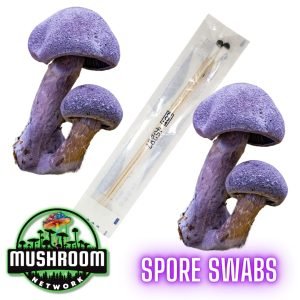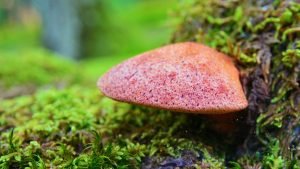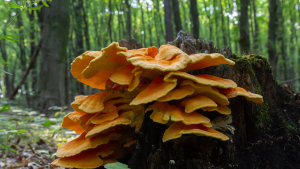Art and psychedelics share a profound connection, with mushrooms, particularly psilocybin-containing species, serving as both a source of inspiration and a catalyst for creative exploration. For decades, artists have turned to mushrooms not only for their psychoactive effects but also for their symbolic richness, using their unique forms and cultural meanings to convey transformation, self-discovery, and the interconnectedness of life. Psilocybin mushrooms, in particular, offer an unparalleled gateway to altered states of consciousness, expanding the boundaries of perception and creativity.
Psilocybin Mushrooms and Altered Perception in Art:
Psilocybin, the psychoactive compound in certain mushrooms, significantly alters the brain’s perception of reality, leading to intensified sensory experiences. Colors become richer, patterns more complex, and the visual field often morphs into abstract forms reminiscent of fractals. Artists who ingest psilocybin frequently experience synesthesia—a blending of the senses—where sounds may take on color, or visual shapes are associated with emotions. These sensory distortions are often translated into psychedelic art, where the boundaries of the physical world are blurred, giving way to surreal landscapes and visions.
One notable effect of psilocybin is the enhancement of pattern recognition. Many artists describe seeing intricate, repeating designs that resemble ancient sacred geometry, which is often mirrored in the art they produce. The experience of ‘ego dissolution,’ where the sense of self melts away, further encourages abstract depictions, as artists express the feeling of unity with the universe.

Mushrooms as Symbols of Transformation:
Mushrooms, by their very nature, are symbols of change. Emerging from the earth in hidden mycelial networks, they represent cycles of life, death, and rebirth. This transformative quality resonates deeply in psychedelic art. Mushrooms are often depicted as mystical gateways, leading individuals on journeys of spiritual enlightenment and personal growth. Amanita muscaria, with its iconic red and white speckled cap, has long been associated with shamanic traditions and otherworldly experiences, adding to its symbolic weight in artistic depictions.
In many pieces of psychedelic art, mushrooms appear as both literal and metaphorical guides, representing the threshold between the conscious and subconscious. Their forms are fluid, organic, and often anthropomorphized, as artists tap into the surreal world of the mushroom’s lifecycle, blending nature with mystical imagery.
Influential Artists and Their Mushroom-Inspired Creations:
Many artists have openly discussed their experiences with psilocybin and its impact on their creative output. Alex Grey, a leading figure in visionary art, frequently explores themes of interconnectedness, often drawing on his own psychedelic experiences. His intricate depictions of the human body and spiritual energy fields—captured in works like The Net of Being—echo the sensations of unity and cosmic consciousness commonly reported during psilocybin experiences.
Similarly, Mati Klarwein’s psychedelic album covers, including the artwork for Santana’s Abraxas and Miles Davis’s Bitches Brew, overflow with mushroom-like landscapes, fractals, and other surreal imagery influenced by Klarwein’s exploration of altered states. His works became emblematic of the countercultural movement of the 1960s and 70s, where psychedelic mushrooms and artistic rebellion went hand in hand.

Psychedelic Art as a Cultural Movement:
Psychedelic art emerged as more than just an aesthetic choice—it became a cultural movement. In the 1960s, the growing use of psychedelics, including psilocybin mushrooms, catalyzed an era of social and spiritual revolution. Artists, musicians, and writers began to push back against rigid societal norms, and psychedelic art became a visual representation of this rebellion. The swirling, colorful, and often chaotic depictions in psychedelic artwork mirrored the counterculture’s desire to transcend boundaries, both personal and societal.
Mushrooms, with their deep connections to indigenous spirituality and their ability to induce profound shifts in consciousness, became powerful symbols of the movement. They represented nature’s ability to heal, transform, and challenge the status quo, making them central figures in the art and culture of the era.
The Role of Digital Art in the Evolution of Psychedelic Expression:
With the advent of digital tools, psychedelic art has entered a new frontier. Virtual reality, 3D modeling, and fractal-based digital animations allow modern artists to explore psychedelic visual experiences in unprecedented ways. These tools offer artists the chance to create immersive, interactive works that mimic the sensory overload experienced during a psilocybin trip. Artists now craft entire worlds based on the vivid hallucinations, geometric patterns, and other visual effects induced by mushrooms, making psychedelic art an evolving, dynamic field.
Artists such as Android Jones, known for his digital and virtual-reality-based art, push the boundaries of how we visualize altered states of consciousness. His works, filled with sacred geometry and kaleidoscopic forms, are heavily influenced by psychedelic experiences and reflect the ongoing relationship between technology and psychedelia.
The universe of mushrooms is expansive, each variant bearing its own unique charm and characteristics. The Marketplace on the 🍄 Mushroom Network is a testament to this diversity. It is a haven for those seeking a deeper understanding of the magical world of mushrooms. If you’re keen on learning more about this type of mushroom and other mushroom variants, this Marketplace is your ultimate resource.
Woah there, eager beaver! 🦫 The 🍄 Mushroom Network’s Marketplace is a smorgasbord of mycological marvels, but it’s VIP access only! 🔐 Log In or Become a Myco-Patron (Yup, still FREE!) to see what all the fuss is about. Trust us, you’ll want in on these shroomy shenanigans! 🍄🎉

Scientific Studies and the Role of Psilocybin in Creative Expression:
Recent studies on psilocybin have revealed fascinating insights into how the compound influences the brain, particularly its effects on creativity. Psilocybin has been shown to increase connectivity between different regions of the brain, allowing for more fluid and less constrained thought patterns—ideal conditions for creative breakthroughs. Artists who use psilocybin often describe an enhanced sense of flow and inspiration, where the boundaries of logic dissolve and pure, unfiltered creativity takes over.
Furthermore, the concept of neuroplasticity, or the brain’s ability to reorganize itself, is heightened during a psilocybin experience. This increased plasticity is often linked to the “aha” moments that many artists report, where creative solutions and artistic inspiration appear seemingly out of nowhere.
Not sure where to start? The 🍄 Mushroom Academy offers a wide range of courses tailored to your needs. Whether you’re a beginner eager to learn or an experienced mycologist looking to broaden your knowledge, the 🍄 Academy has something for everyone.

Conclusion:
The relationship between mushrooms and art, particularly through the lens of psilocybin, continues to shape artistic expression in both traditional and digital mediums. From the countercultural revolutions of the 1960s to the modern digital age, mushrooms remain powerful symbols of transformation, interconnectedness, and the boundless possibilities of human creativity. As psilocybin research advances and public perception shifts, we can only expect this relationship to deepen, inspiring new generations of artists to explore the psychedelic canvas.
Love what you’re reading? Make it FBO (Facebook Official) with us! 🤘🏼 Hit that subscribe button on YouTube, follow our Facebook Page, join our FB Group – Wood Wide Web, and chirp along with us on Twitter/X. While you’re at it, peep into the 🍄 Mushroom Network’s Marketplace—where our Network shelves change faster than a Pink Oyster (Pleurotus Djamor) pins!
Recommended Reads:
Beefsteak Mushroom (Fistulina Hepatica)
Welcome, fungal enthusiasts and curious minds, to an exploration of Fistulina Hepatica, commonly known as...
Read More...Mastering Mushroom Cultivation – From Spores to Harvest
About This Article: Unlock the world of home mushroom cultivation with this comprehensive guide! Discover...
Read More...Breeding the Bright: Cultivating Chicken of the Woods
Embarking on a home-based mushroom cultivation journey is not only fascinating but also rewarding. Among...
Read More...Mini-Puffball (Bovista Dermoxantha)
Scientific Name: Bovista Dermoxantha COMMON NAME(S): Mini-Puffball | Small Puffball | Little Puffball Welcome to...
Read More...Whoa there, Spore Sport! 🍄 Looks like you’re not logged in yet. Don’t you know what you’re missing? MYCO-CREDITS! Imagine all the fungal fun you could have. It’s like finding a Morel in May and not picking it. Tragic, right? Log In or Become a Myco-Patron and start racking up those credits. It’s more rewarding than finding a mushroom in your backyard! 🌟🏡













